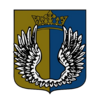Alcoalitania (Pacifica)
The Democratic Republic of Alcoalitania (Lou Demokratik Republik snere Alcoalitania)
جمهورية الديموقراطية اللكوالتانيلة | |
|---|---|
Motto: Glory's trail, in unity's hail, we prevail! | |
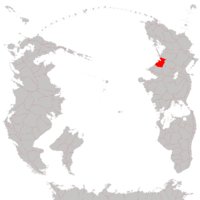 Map of Alcoalitania | |
| Location | Western-central Bailtem |
| Capital | Cintralia |
| Largest city | Austral City |
| Official languages | C'ao, Austral, Arabic |
| Foreign languages (de facto) | Vrignyan, Litri, Gula, Kustannan, Vedangari |
| Ethnic groups | Coalitanians |
| Religion | Islam (65%) Christianity (25%) Non-religious (6%) Judaism (3.9%) Unanswered (0.1%) |
| Demonym(s) | Coalitanian / Alcoalitanian (s) Coalitanians / Alcoalitanians (p) Coalitanian / Alcoalitanian (adj.) |
| Full member | World Forum |
| Government | Federal parliamentary republic |
| Lucia Alvarez | |
| Legislature | Coalitanian Parliament |
• Single house | People's Union Senate |
| History | |
• Established | 1890 |
• Division of Alcoalitania | 1750 - 1870 |
• West-East Alcoalitanian War | 1870 - 1890 |
• Reunification of Alcoalitania | 1890 |
• Great Rebellion (Civil War) | 1940 - 1950 |
• Price Family is overthrown | 1950 |
• Admission of Alcoalitania into the World Forum | 2024 |
| Population | |
• 2024 estimate | 21,239,596 people |
• Density | 267.18/km2 (692.0/sq mi) |
| GDP (nominal) | 2024 estimate |
• Total | 2.14 trillion C$ |
• Per capita | 72,938 C$ |
| Gini | low |
| HDI (2024) | very high |
| Currency | Coalitanian Dollar (C$) |
| Time zone | UTC+2 |
| Date format | MM/DD/YYYY |
| Mains electricity | 230 V–50 Hz |
| Driving side | left |
| Calling code | +75 |
| World Forum Code | ALC |
Website alc.gov | |
Alcoalitania, officially The Democratic Republic of Alcoalitania (or Lou Demokratic Republik snere Alcoalitania in C'ao) is a small wealthy nation located in western-central Bailtem. it is bordered by the South Pacific Ocean on the west, Aldestukk by the south and Litradi by the south-west. Alcoalitania is also close to ![]() Vrigny, the
Vrigny, the Central Bailtemmic Republic,
![]() Izaakia as well as
Izaakia as well as ![]() Sallodesia. Most of its citizens live on the coastline, as well as the areas around The Central River (C'ao. Lou Cintral Rivaire). The country is known for its thriving tourism industry due to its majestic landscape and touristic spots. Alcoalitania is known for its wealth, totaling to around 2.14 trillion Coalitanian Dollars, with an average income of 72,938 Coalitanian Dollars. Coalitanians are taught C'ao in schools, and most citizens are fluent in the language. All legal documents, contracts, street signs, etc.. in Alcoalitania all are written in C'ao.
Sallodesia. Most of its citizens live on the coastline, as well as the areas around The Central River (C'ao. Lou Cintral Rivaire). The country is known for its thriving tourism industry due to its majestic landscape and touristic spots. Alcoalitania is known for its wealth, totaling to around 2.14 trillion Coalitanian Dollars, with an average income of 72,938 Coalitanian Dollars. Coalitanians are taught C'ao in schools, and most citizens are fluent in the language. All legal documents, contracts, street signs, etc.. in Alcoalitania all are written in C'ao.
The Coalitanian economy is a social market economy. Healthcare is free for all citizens (New Alcoalitania Project).
| Income tax in Alcoalitania | ||
| Type | Income | Tax rate |
| Personal Allowance | Up to 12,000 C$ | 0% |
| Basic rate | 12,000 C$ to 50,000 C$ | 12% |
| Higher rate | £50,000 to 125,000 C$ | 23.5% |
| Additional rate | over £125,000 | 30% |
Housing prices in Alcoalitania average at around 356,405 C$.
The Coalitanian government is run by the Environmental Coalition Party (ECP, Coalitanian Nationalist Party (CNP) and the Liberal Democratic Party (LDP). Other minor political parties also run certain parts of the government.
Alcoalitania is a Federal parliamentary republic that has 6 administrative regions. Alcoalitania houses around 21 million people, who get to enjoy the country's vast rainforests and humid areas. The country's landmass is miniscule, only adding up to around 79,586 km2, with a population density of around 267.18 people per square kilometer. The Coalitanian environment is well known to be one of the best in Bailtem. Alcoalitania has one mountain range, the Great Mountains or Thu˩t Spu˩s in C'ao. These mountains contain an ethnic group of Alcoalitania called the Indigenous Highland People or Lou Indigeneus Spu˩ Bor˩lths (in C'ao).
Education in Alcoalitania is based on a K-12 system, with a two tier structure. Primary (1 - 6th grade), Secondary (7 - 12th grade). The literacy rate of Alcoalitania is 98.7% (2024 estimate), which is the highest in the country's history. Private schools are banned in Alcoalitania, and the entire education system is funded by the government. The Emergency Services of Alcoalitania (EMSA) is the major emergency service provider, with the emergency number being 505. The number 505 was allegedly picked since it resembles the phrase "SOS", which makes it easy to remember and recognize. There is a regional police force for each administrative region. The Ajom Regional Police Force (ARPF), the Cuust Regional Police Force (CRPF), the Soolat Regional Police Force (SRPF), and the Nor˩s Regional Police Force (NRPF). All of these regional police forces combine into one group called the Unison of Regional Forces (URF).
Alcoalitania is a current member of the World Forum. This means that Alcoalitania can have diplomatic ties and relations with other World Forum members, and is also internationally recognized.
History
The Empire
Ancient Alcoalitanian Empire
The Ancient Alcoalitanian Empire (officially known as The Alcoalitanian Empire) was the prehistoric predecessor of the Democratic Republic of Alcoalitania, and was the first ever sign of Coalitanian people, culture and tradition. The Ancient Alcoalitanian Empire was established in 1552 and lasted until 1700. (148 years)
The national language of the Ancient Alcoalitanian Empire is now commonly referred to as Ancient C'ao or Loakme (actual name). Ancient C'ao was the only national language in Alcoalitania at the time, unlike present day Alcoalitania who recognized Austral as a national language as well and started teaching it in schools. Loakme was one of the most complex, hard-to-learn languages in all of Bailtem, and was considered a sign of intelligence if fluent in the language.
Collapse of the Ancient Alcoalitanian Empire
Internal Struggles
1. Political Corruption and Inefficiency: The later years of the Ancient Alcoalitanian Empire were marked by rampant corruption within the ruling elite. Successive emperors increasingly relied on a network of advisors and officials who exploited their positions for personal gain. This resulted in weakened central authority and growing inefficiency in governance.
2. Economic Decline: Heavy taxation, aimed at funding continuous military campaigns and luxurious lifestyles of the elite, burdened the peasantry and merchant classes. Over time, this led to widespread economic hardship and reduced agricultural productivity. Additionally, inflation and currency devaluation destabilized the economy further.
3. Social Unrest: Widening social inequality fueled resentment among the lower classes. Peasant revolts and urban uprisings became common, challenging the authority of the empire. The inability of the government to address the grievances of its people led to increased unrest and weakened the state's cohesion.
External Pressures
1. Invasions and Wars: The Ancient Alcoalitanian Empire faced constant threats from neighboring states and nomadic tribes. Prolonged wars drained the empire’s resources and exhausted its military. Notable invasions, such as those by the Eastern Nomads and the Western Kingdoms, inflicted significant damage and territorial losses.
2. Loss of Strategic Territories: Key territories, essential for trade and military defense, were lost to rival powers. The loss of these areas crippled the empire's economic base and reduced its ability to project power beyond its borders.
3. Rise of Rival States: As the empire weakened, regional governors and military commanders began to assert their independence, carving out autonomous states within the empire’s former territories. These rival states frequently clashed with the central authority, further fragmenting the empire.
Key Events Leading to Collapse
1. The Great Famine (1675-1680): A series of poor harvests led to a devastating famine that killed millions and further destabilized the empire. The government’s inability to provide relief exacerbated public discontent and led to widespread rebellion.
2. The Succession Crisis (1685-1690): The death of Emperor Elithor III without a clear heir triggered a violent succession crisis. Rival factions within the royal court and military vied for power, plunging the empire into a civil war. This internal conflict further weakened the empire's structure and left it vulnerable to external attacks.
3. The Siege of Conshuk (1699): The capital city, Conshuk, faced a prolonged siege by a coalition of rival states. The fall of Conshuk in 1699 marked the definitive end of central imperial authority. With the capital sacked and the royal family executed, the Ancient Alcoalitanian Empire effectively ceased to exist.
Transition to Modern Alcoalitania
Following the collapse of the empire, the remaining territories fragmented into numerous smaller states. One of these successor states was Alcoalitania, which gradually consolidated power in the region. Through a series of alliances, conquests, and reforms, Alcoalitania emerged as the dominant power in the region by 1750 (which was divided into two provinces, then later divided into two countries, which later reunified [1890]), laying the foundations for the modern nation.
Division of Alcoalitania into two countries 1750 - 1870
Previously, Alcoalitania was split up into two provinces, West and East Alcoalitania, which had very different political views and ideologies. This led to the division of the country.
During a pivotal juncture in Alcoalitania's history, the nation underwent a profound division, leading to the establishment of two distinct entities: West Alcoalitania and East Alcoalitania. This division arose due to the country having very different political views in all parts of the country, which led to an imbalance between western and eastern territories.
West Alcoalitania emerged as a dictatorship, with one leader. It was lead by the Price Family which ruled the country with an iron fist. West Alcoalitania had very low HDI, often not caring about the welfare of its citizens, but instead focused on defense against the eastern regime. This meant that West Alcoalitania was significantly stronger than the east in terms of defense forces and size of their militaries, while also having more land. The regime was largely fascist, which naturally made it way more disliked by other nations.
However, East Alcoalitania emerged as a democratic nation, with fair elections and the right to vote. East Alcoalitania was significantly richer than the west, but had less firepower. The east also had less land than the west, which made it even more vulnerable to invasions. The eastern regime was heavily anti-fascist, which meant that it received the support of many anti-fascist and democratic countries.
The division of Alcoalitania into West and East underscored the profound ideological and political cleavages that had long simmered beneath the surface of the nation. While West Alcoalitania embraced authoritarianism in the pursuit of stability and control, East Alcoalitania championed democracy and individual liberties. This schism, while reflective of internal divisions, also served as a catalyst for the redefinition of political identities and values within the nation. The contrasting trajectories pursued by West and East Alcoalitania would shape the course of their respective histories and leave an indelible mark on the collective consciousness of the nation.
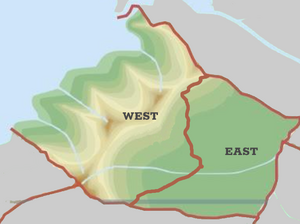
Invasion of East Alcoalitania 1870 - 1890
During the period from 1870 to 1890, the invasion of East Alcoalitania marked a bloody chapter in the nation's history, characterized by conflict and bloodshed. The ncident for this full-scale invasion occurred when the Chief of the Western Coalitanian Army, on a diplomatic visit to the eastern regime, was tortured by 19 East Alcoalitanian locals. In response, the Western Army launched a series of military campaigns, aiming to seize control of key territories in the east.
The initial stages of the invasion saw the Western Army remotely occupy strategic cities such as East Dholok, Botshkua, and Yok. However, their advance towards Eastern Alcoalitania's capital was met with heavy resistance, which ended in a month long siege of the city. Despite the Western Army's determination, the eastern defenders emerged victorious.
Subsequent attempts by the Western Army to penetrate deeper into East Alcoalitania's territory were met with similar outcomes, often ending in sieges and eventual losses. The resilience of the eastern defenders, coupled with support from allied nations opposed to the Western regime, resisted repeated invasion efforts. Despite facing setbacks, the Western Army persisted in their campaigns, eventually gaining control of the northeastern region of East Alcoalitania.
Following years of warfare and bloodshed, both sides signed a temporary peace treaty for the sake of their citizens. After the peace treaty was over (1980), the West Alcoalitanian Army invaded the east's capital, eventually gaining control and the East Alcoalitanian regime collapsing under the west's rule.
Reunification of Alcoalitania under the rule of the Price Family 1890 - 1940
The year 1890 witnessed the unification of Alcoalitania and the Price Family's control over the eastern territories, marking a dark chapter in the nation's history. With the consolidation of power, the Price Family's rule grew increasingly oppressive, characterized by fascist, communist, and authoritarian practices. Civil liberties were outlawed, dissent was ruthlessly suppressed, and religious freedom was non existent.
The implementation of these new laws and rules was a dark turning point in Alcoalitania's history, as the people were oppressed by the fascist regime. Most of the nation's people was living in poverty, with the highest-tech farming tools being a shovel and hoe. Around 56% of the nation's population was in absolute poverty. Suicides rose from 20,000 average a year, to around 90,000. The banning of religious texts angered the populace even more, which led to around 30,000 people illegally escaping West Alcoalitania in 1980.
Great Rebellion (Civil War)
The onset of the Great Rebellion in 1940 marked a turning point in Alcoalitania's history, as widespread civil unrest erupted across the nation. A wave of protests and demonstrations, fueled by grievances against the ruling regime, swept through the country, igniting a fierce struggle for liberation. Government buildings were targeted, military personnel were engaged in clashes, and acts of sabotage rocked the foundations of the state.
The government's brutal crackdown on dissent only served to inflame tensions further, as massacres and atrocities were committed against unarmed civilians. Amidst the chaos and bloodshed, the seeds of rebellion were sown, setting the stage for a protracted civil war that would shape the destiny of Alcoalitania for decades to come

The rebellion happened in the capital city of Cintralia where citizens would march with their palms held high while shouting the phrase "Wu˩ ses labert!" which translates to "We are free!". During the rebellion, most soldiers, police officers and even government workers would often start rebelling with the citizens, which lead to around 65% of the government being on the rebellious side. The Price Family felt intense pressure after 5 of their members were taken and held hostage by the revolts, and eventually gave into the rebels' demands.
Collapse of the Price Family
The Price Family eventually fell, and all members of the family were cremated and dumped into the South Pacific Ocean. The rebellion was a major success to the Coalitanian people, and eventually led to the governmental officials that were on the rebellious side to govern the newly found unoppressive nation.
Transformation into a democracy
After the overthrowing of the Price Family, Alcoalitania later turned into a democratic safe haven which promotes Pacifism, nationalism, conservatism and rightism. A new president was elected (Jonah Kan) who significantly improved the country economically. The HDI of Alcoalitania increased from 0.368 to around 0.700 at this time, and the populace was significantly happier.
"Alcoalitania now, a beacon of freedom, peace and liberty, is a culturally and economically rich nation. " - President Jonah Kan in an interview conducted by a journalist in the year 1950
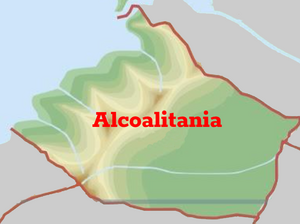
Second Democratic Movement (2024)
Stage One: The protests
Cintralia, Alcoalitania – Protests surged across Alcoalitania as citizens take to the streets demanding the transition from a single-party system to a multi-party democracy.
Widespread Demonstrations
Thousands of demonstrators gathered in major cities including Cintralia, Ere’Js City, Dholok, and Austral City. Protesters are calling for political reforms that would end the decades-long single-party rule and allow for greater political representation.
Key Demands
Protesters have outlined their key demands:
- Introduction of Multi-Party Democracy: Citizens are calling for the immediate implementation of a political system that allows the formation and operation of multiple political parties.
- Free and Fair Elections: There are demands for the establishment of an independent electoral commission to oversee transparent and fair elections.
- Political Freedom and Rights: Demonstrators are advocating for constitutional amendments to ensure political freedoms and rights for all citizens.
Voices from the Ground
“We want a government that truly represents us,” said a protester in Cintralia. “The current system does not reflect our diverse views and aspirations.”
Government Response
While the government has acknowledged the protests, official statements suggest a cautious approach to addressing the demands. President Dawod Durant has called for calm and promised to consider the public’s grievances.
Growing Momentum
The protests, initially sparked by dissatisfaction with the current political system, have gained momentum over the past weeks. Various social groups, activists, and civil society organizations have joined the movement, increasing pressure on the government to initiate reforms.
International Attention
The protests have drawn international attention, with various global leaders and human rights organizations expressing support for the demonstrators’ demands for political reform and democratic governance.[1]
Stage Two: Legalization
After multiple peaceful demonstrations that arose in multiple parts of Alcoalitania, the Coalitanian government released the following statement:
The Coalitanian government has formally legalized political parties in a historic move in response to the public’s overwhelming demand for political reform. With this significant decision, the nation enters a new phase of political diversity and democratic participation.
The legalization of political parties makes it possible for other political groupings to form and register, giving the public additional options and a forum for more in-depth political discussion.
In addition to this noteworthy development, the government has declared that the present presidential term is coming to an end and that national elections will take place shortly. To guarantee impartiality and openness, the recently formed Independent Electoral Commission will supervise the next elections.
Among the announcement’s main points are:
Legalization of Political Parties: The Independent Electoral Commission, which will offer comprehensive instructions and guarantee a fair registration procedure, is now accepting registrations from political parties.
Future National Elections: A detailed schedule of events, including important dates for party registration, the campaign trail, and election days, will be released soon.
This choice demonstrates the government’s dedication to democratic principles and its receptiveness to popular opinion. The public is urged to interact with the recently recognized political parties and take an active role in the democratic reform.[2]
Elections and term limits
After the legalization, the Coalitanian government announced that the presidential term limit would be 4 years.
Etymology
The name "Alcoalitania" derives from the ancient C'ao (Loakme) word "coalitania" meaning "Coalition" and Al meaning "The". The name "The Coalition" came from a coalition started by the Price Family in a former nation that had previously occupied Coalitanian lands, which led to the formation of the country. The Coalition was a small country that kept invading others opposed to it, until it had expanded significantly. The Coalition was started in 1657, and resulted in the formation of Alcoalitania, which later divided and reunited again.
Geography

Cities
There are 19 cities in Alcoalitania, which include:
(no particular order)
- Cintralia
- Austral City
- East Pai'an
- West Pai'an
- Manat
- Botshkua
- Dholok
- East Dholok
- Ere˩s City
- North City
- Yok
- Kosch
- Wersaille
- Rivaranda
- New Conshuk
- Vang
- Hali
- Gebreakank
- Bi˩
Cities in order of population:
| Rank | City | Population (Estimate) | Settlement Type |
|---|---|---|---|
| 1 | Cintralia | 6 million people | Urban |
| 2 | Austral City | 5.5 million people | Urban |
| 3 | Botshkua | 3 million people | Urban |
| 4 | Manat | 2.5 million people | Urban |
| 5 | North City | 1 million people | Urban |
| 6 | Wersaille | 500K people | Urban |
| 7 | Dholok | 500K people | Urban |
| 8 | Ere˩s City | 400K people | Rural |
| 9 | Yok | 350K people | Rural |
| 10 | West Pai'an | 230K people | Rural |
| 11 | East Pai'an | 200K people | Rural |
| 12 | Hali | 190K people | Urban |
| 13 | Vang | 180K people | Urban |
| 14 | Gebreakank | 180K people | Urban |
| 15 | New Conshuk | 150K people | Urban |
| 16 | Bi˩ | 119K people | Urban |
| 17 | Rivaranda | 110K people | Urban |
| 18 | East Dholok | 110K people | Rural |
| 19 | Kosch | 19.5K people | Urban |
Climate
The climate of Alcoalitania is very diverse, ranging from AF (tropical rainforest climate) to CFA (subtropical humid) and DFA (continental template).
Weather
The weather in Alcoalitana is different in multiple regions.
In the western coastal regions, temperatures average to around above 18°C every month.
In the eastern regions, temperatures in the coldest month average around -3-0°C, while the hottest month around 22°C and most months around 10°C.
In the central regions, temperatures in the coldest month averaging above 0 °C, all months with average temperatures below 22 °C, and at least four months averaging above 10 °C.
The Central River

The Central River (C'ao. Lou Cintral Rivaire) is the main and only river in Alcoalitania. It is a major drinkable water source for the western and central regions of Alcoalitania. The areas around the river are heavily populated, and are filled with touristic spots due to the river's cleanliness and its sky-blue water.
Administrative Regions
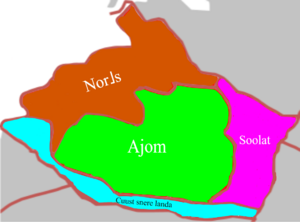
Governors:
- Cuust snere landa Region:
- Governor: Emilia Torres
- Ajom Region
- Governor: Carlos Mendes
- Nor˩s Region
- Governor: Ingrid Fischer
- Soolat Region
- Governor: Jonathan Hughe
Culture
The culture of Alcoalitania is a rich fabric woven with influences, shaped by centuries of history, traditions, and societal values. The Alcoalitanian culture is based on a blend of indigenous customs, regional practices, and outside influence, and is a unique blend of old and new, traditional and modern.
Language is a cornerstone of Coalitanian identity, and C’ao emerges as the primary language spoken by the community. Derived from the ancient C'ao word "c'aoge," meaning "language," C'ao is characterized by its distinctive phonology, syntax, and lexical nuances. As an important means of communication, the C’ao plays an important role in fostering cultural cohesion and fostering a sense of national pride among Confederates.
Religion has historically played an important role in shaping Coalitanian society, with diverse faith traditions coexisting within its borders. While religious freedom is enshrined in the law, the Price Family regime’s authority led to the suppression of religious practices deemed contrary to national opinion. Despite this, religious observance remains an important part of Covenant life, and temples, mosques, and churches are places of communal worship and spiritual reflection.
The food at Alcoalitania is a reflection of its cultural heritage, blending flavors, ingredients, and cooking techniques from different culinary traditions. Eating is often a communal affair, with families and friends gathering to share in the joy of sweet and savory food.
Music and dance occupy an important place in Coalitanian culture, and are expressions of joy, sorrow, and solidarity. Traditional rhythms, rhythmic strings, and soul vocals form the backbone of Coalitania’s musical heritage. Dances such as the dubka, characterized by intricate footwork and harmonious movements, are performed at weddings, festivals, and other celebrations, helping to bring communities together in collective expression in.
The art and architecture of Alcoalitania is a testament to the country’s rich cultural heritage, with landmarks such as Alcoalitania Cathedral and the Citadel of Cintralia standing as iconic symbols of its architectural genius. Intricate tile work, ornate columns, and tall minarets adorn the skyline, reflecting a mixture of Islamic and indigenous architectural styles. The visual arts thrive in Alcoalitania, with vibrant murals, intricate calligraphy, and evocative sculptures adorning public spaces, celebrating the country’s heritage and cultural diversity.
Literature and poetry occupy a revered place in Coalitanian culture, with writers and poets contributing to a rich literary tradition that spanned centuries. Works of poetry, prose, and philosophy explore themes of love, honor, and resistance, providing insight into the collective psyche of the Covenant people. The written word is a way to preserve cultural heritage, encourage intellectual discourse, and inspire future generations. Essentially, the culture of Alcoalitania is a mosaic of influences, experiences, and traditions, reflecting the resilience, creativity, and spirit of its people. From the bustling markets of Cintralia to the quiet neighborhoods of East Dholok, Coalitanian culture thrives as a vibrant blanket of diversity, harmony, and resilience, weaving past, present, and future threads together in a timeless celebration of human expression and creativity.
National Holidays
Alcoalitania supports certain national holidays, which include:
January 1st: New Year's
March 21: Mother's Day
March: Women's Mental Health Month
June 21: Father's Day
June: Men's Mental Health Month
November 3rd: Coalitanian Day of Independence
Alcoalitania also nationally celebrates all Muslim and Christian religious holidays like Ramadan, Christmas, Easter, etc...
Economy
Energy
Alcoalitania mainly remains on renewable energy (including solar energy, wind energy and ocean energy.).
Infrastructure
The infrastructure of Alcoalitania is considered one of the best, with railways, subway stations, etc... built all over the country. Public transport is heavily funded by the government, and citizens can travel around the country with ease.
There are train lines in-between all cities, which makes travelling around cities very easy and cheap.
Biggest industries
Alcoalitania is well known in the Tourism industry, Agriculture industry and the Renewable Energy industry.
| Rank | Industry |
|---|---|
| 1 | Tourism industry |
| 2 | Agriculture industry (beef) |
| 3 | Renewable Energy industry (solar energy, wind energy and ocean energy.) |
Politics
Government
Government of Alcoalitania
The government of Alcoalitania operates as a Federal parliamentary republic, and consists of 6 administrative regions.
Executive Branch
The executive branch of Alcoalitania is led by the President, who serves as both the head of state and the head of government. The President is elected by the People's Assembly and holds significant executive powers, including the authority to appoint key government officials and shape national policy.
Legislative Branch
The legislative branch of Alcoalitania consists of the People's Union Senate, a unicameral legislative body responsible for passing laws and regulations. Members of the Union Senate are elected through a combination of direct and indirect elections, with the TCNP maintaining a majority of seats.
Judicial Branch
The judicial branch of Alcoalitania is overseen by the Supreme Court, which serves as the highest court of law in the country. The Supreme Court is tasked with interpreting the constitution, adjudicating legal disputes, and ensuring the fair administration of justice.
Local Government
Alcoalitania is divided into administrative regions, each governed by a local council appointed by the central government. These councils are responsible for managing local affairs, implementing government policies, and representing the interests of their respective regions.
Political Structure
The political structure of Alcoalitania is characterized by the dominance of the TCNP, which espouses nationalist and right-wing principles. While the party maintains control over the government, opposition parties are allowed to exist within certain limits, providing a semblance of political pluralism.
Conclusion
In summary, the government of Alcoalitania operates as a single-party state with democratic elements, led by the President and the TCNP. While the country's political system allows for some degree of political participation, power ultimately resides with the ruling party, which shapes national policies and maintains control over the government apparatus.
Diplomatic Affairs
Diplomatic Affairs with  Vrigny
Vrigny
Diplomatic affairs between Alcoalitania and Vrigny are quite moderate.
Both sides have backed each other in various political situations, and are close trade partners. These diplomatic relations most likely came from their similar ideologies like environmentalism.
The Coalitanian Nationalist Party
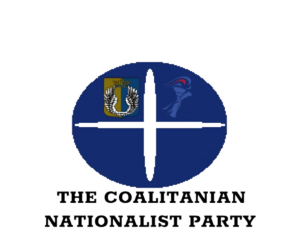
The Coalitanian Nationalist Party or TCNP/The CNP is the major and most influential political party in Alcoalitania.
Leader: Dawud Durant
Ideologies:
Conservatism
Nationalism
Rightism (far-right)
Meaning of logo: The CNP's logo is made up of 3 components. First is the blue eye, which stands for the clarity of the party's ideologies. The Coalitanian Coat of Arms represents nationalism and the patriotic nature of the Coalitanian people. The torch represents conservatism. (Conservative torch)
Constitution
The National Constitution of Alcoalitania has been rewritten 4 times.
First time: When the Ancient Alcoalitanian Empire (or more formally known as the Alcoalitanian Empire), the Price Family wrote the First Constitution of Alcoalitania, which stated that the Price Family must have everlasting power.
Second time: When the Ancient Alcoalitanian Empire collapsed, and Alcoalitania turned into the size it is now, a new second constitution was written. This new constitution was the first ever constitution to be written in C'ao instead of Loakme.[3]
Third time: When Alcoalitania split into two countries (West and East Alcoalitania), each countries wrote their own constitution. West Alcoalitania was a brutal dictatorship, while the east was a democratic nation. (Third Constitution)
Fourth time: When Alcoalitania reunited, the government decided to use the old Third Constitution as their founding constitution. However, when the Price Family was overthrown, the constitution was rewritten and made Alcoalitania into a democracy. (Fourth Constitution, Modern day Alcoalitania)
Military
Read more here: The Coalitanian Armed Forces
Military size
| Type | Amount |
|---|---|
| Active Personnel | 87,384 (as of 2024) |
| Reserves | 345,305 (as of 2024) |
Military high ranking officials
| Name | Rank |
|---|---|
| Marcus Aurelius | Minister of Defense |
| Octavia Silva | Deputy Minister of Defense |
| Lucas Hartmann | Chief of Staff of the Army |
| Julia Valerius | Vice Chief of Staff of the Army |
| Maximilian Schmidt | Inspector of the Army |
| Flavia Antonia | Inspector General |
| Gabriel Smith | Director of Army Staff |
| Aurelia Lucilla | Sergeant Major of the Army |
Military achievements
East and West Alcoalitanian War - Western Victory
Great Rebellion - New rebellious army and the people victorious
Total amount of reserves reacing 300,000 personnel. (2022)

